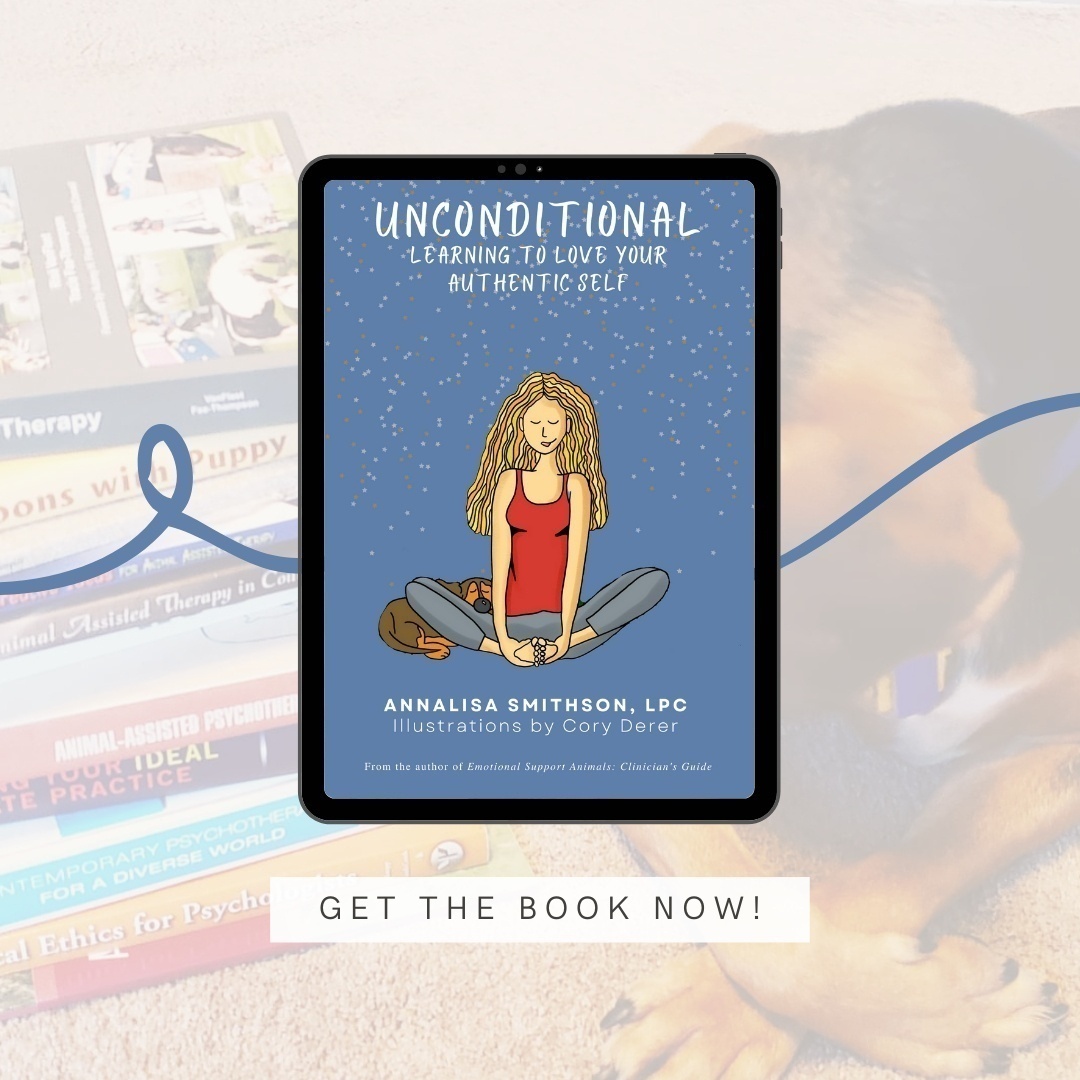Practicing Whole Self Care

The following is an excerpt from Unconditional: Learning to Love Your Authentic Self by Annalisa Smithson, LPC (available on Amazon now!)
You are probably quite good at certain types of self-care—when you give yourself permission to indulge. But did you know there are multiple domains of self-care? Let’s explore the four primary domains and select a few examples from each that fit your style.
But first, a point to remember: self-care isn’t escapism (at least not entirely).
Some self-care activities will help you escape from the stressors in your life for a period of time. They give you space from your problems—a little more length on your leash, so to speak. They give you the opportunity to balance yourself, recharge your batteries, and find where you buried your favorite bones. In order to return to the problems later and feel confident enough to solve them, you need to make time for self-care. In other words, taking a temporary distraction from your stressors can be helpful. Just be careful you don’t fall down the rabbit hole of habitually avoiding your problems. You want to aim for a healthy, temporary distraction, rather than an unhealthy, bound-to-fail pattern of avoidance. Now let’s explore the four domains. They are:
Physical Self-Care
Cognitive Self-Care
Emotional Self-Care
Realistic Self-Care
Let’s jump right in.
Physical Self-Care
Have you ever experienced a runner’s high? That moment, about seven or eight minutes into your jog, when everything just clicks into place. You experience a brief, beautiful sense of euphoria. Cramps disappear, side-stitches ease, your breathing becomes deeper, faster, and more fulfilling. You feel like you’re sailing along the trail and you remember how much you love running. It’s a real thing and it isn’t limited to running. A “runner’s high” can happen when you’re swimming, biking, or even taking Doggo on a long walk. When you do something that gets your blood pumping and your oxygen flowing, your brain releases feel-good hormones called endorphins. These are natural painkillers that your brain controls and your activity can trigger. They may be part of the reason exercise feels so damn good. Scientists have also suggested that norepinephrine secretion, dopamine, or serotonin could be the neurotransmitters that give us such a good time during exercise. Whatever the mechanism, it’s an accepted fact that long, rhythmic aerobics create opportunities for the brain to counter the effects of stress and anxiety.
Jada Rohner, certified dance and fitness instructor, explains the impact of exercise on stress: “When our bodies function better, our minds are more at ease. Rigorous exercise releases endorphins which make people feel like they are on a natural high. Runners and dancers often speak of this effect after a great workout. Cardiovascular aerobic exercise boosts our energy and makes us feel like we are more motivated to get through our daily routine. Those who practice yoga or Pilates speak of a similar effect, but they use words like ‘calming’ and ‘centering.’”
Rohner describes other physiological benefits of exercise, such as the oxygenation of blood, the release of serotonin during deep belly breathing, and the easing of tensed muscles from simple stretches such as neck and shoulder rolls. Think about it: scrunching your face, grinding your teeth, and tightening your neck and shoulders are probably a few things you unknowingly do whenever you experience stress. Some of these involuntary expressions of stress can lead to migraines, back pain, and ultimately even more discomfort and stress.
As Rohner says, “For many, myself included, the simple act of exercise is the ultimate form of self-care. We can put down whatever is causing us stress for an hour or so. We can clear our heads for a time and release the stress from our bodies in a healthy way. This allows us to recharge mentally and look at whatever is causing us stress in a new and sometimes more effective way.”
So how will you incorporate physical self-care into your daily life? You could play a competitive sport, try hot yoga, dance like a toddler, or strap on some roller skates. You could swim across the lake and even take some time to splash, just for fun. You could simply stretch at the beginning and end of each day. And—how could I forget?—you could walk your dog! Whatever physical self-care you choose, try to have some fun with it! Grab your journal and write about some of the physical activities you enjoy:
When you have been stressed in the past, what kind of physical activities gave you release?
Do you enjoy solo exercise, a class-like setting, or full-on competitive sports?
What was the last physical activity that left you feeling focused and energized? (For me, it was paddle-boarding!)
Cognitive Self-Care
Cognitive self-care is just a fancy way of saying you need a “brain break.” (My daughter tells me that’s what they call it in elementary school.) It includes any activity that engages and focuses the mind, thereby taking your attention away from the thing causing you stress (such as common core math). The goal is to offer up your energy to your intellectual and/or creative self. Instead of ruminating on your problems, you force the problem to “sit and stay” for a time. It’s amazing how often a solution to the problem occurs to you while you’re on a “brain break.”
One of the best examples of cognitive self-care is guided meditation. A daily meditation habit is second only to sleep for rejuvenation and good health. You learned about the science of meditation in an earlier chapter. Continue investing in yourself with five minutes per day of guided meditation because that will precipitate incredible growth. Your ability to maintain serenity in the face of stress may well astonish you. Like a flower being nurtured every day with a cool drink of water, your cognitive abilities will blossom.
Other examples of cognitive self-care include working on a jigsaw puzzle, or doing sudoku, mahjong, or even a simple word-find. A more creative approach might be knitting, painting, or sculpting. In my group therapy room at the clinic, I kept a constantly evolving list of art-based therapeutic activities along with the corresponding materials. The shelves were lined with everything from adult coloring books to an old, well-loved guitar. People spent hours in that room crafting and creating, all the while noticing their thoughts, feelings, and any decisions that bubbled to the surface.
As a self-proclaimed bibliophile, my favorite types of self-care involve the written word. Losing myself in some fantasy fiction (I rarely aim for thought-provoking when the goal is self-care) is the fastest route to relaxation for me. And as an ambivert, I love the fact that reading is a portable self-care activity. I can take my latest novel to the local bookstore/cafe and be surrounded by other bibliophiles. I can also disappear into the woods with a backpack full of snacks and paperbacks. Either way, my ambivert self can find some TLC with a good book.
A word about television. My favorite professor, who later became my mentor and one of the best humans I have ever known, rather callously announced to my cohort once that “watching television doesn’t count as self-care!” We were outraged. “But, Dr. Farrell!” I spluttered, “What about Star Trek?!” As a fellow Trekkie, surely he understood the exception to the rule. I could accept South Park and Real Housewives as outside the realm of self-care, but Star Trek? The show that taught us “that humanity will reach maturity and wisdom on the day it begins not just to tolerate, but take a special delight in differences in ideas…”? (Thank you, Gene Roddenberry.) Rarely do I feel cozier than when I’m curled up with my pets and a cuppa hot tea, watching reruns of Next Generation. But Dr. Farrell was insistent. “You know I love Star Trek. But no, even that. TV doesn’t count as self-care.” It pains me to echo this sentiment, but he was probably right. Watching television can be fun and relaxing, but a daily TV habit won’t give you anywhere near the benefits of a daily meditation or reading habit. Grab your journal, and give the following questions some thought:
What is your favorite type of brain-break?
Were you surprised by any of the cognitive self-care activities listed?
Which cognitive self-care activities could fit in with the recommended hobbies for your personality type?
Emotional Self-Care
No matter what your personality type or where you land on the introversion scale, emotional self-care is critically important. Healthy boundaries and quality alone time are more than just a treat for introverts and bookworms; they are an exceptionally important aspect of emotional self-care. Remember that humans are social creatures. All of us occasionally need a shoulder to cry on, a hand (or paw) to hold, and a great big belly laugh. We need to process our feelings, out loud and with an empathetic person. So please, don’t make all your emotional self-care activities solo activities. Allow yourself to ask for help—or company—when you need it.
Emotional self-care activities might include journaling, calling a friend, seeing a therapist, writing a gratitude list, or practicing compassionate self-talk. Try to nurture your feelings without judgment. It’s hard enough to process feelings of anger or sadness. Don’t fall into the trap of telling yourself you should or shouldn’t feel something. Effective emotional self-care can also happen when you nurture someone else’s feelings. Helping others is often a path to healing ourselves. Practice active listening with someone you love and consider asking someone you love to actively listen to you. Check out the Worksheets section of this book for tips on how to be a better listener.
Here is a simple, straightforward way to practice emotional self-care. The next time someone gives you a compliment, accept the compliment. If you notice your inner critic objecting, downplaying, or dismissing the compliment, give your critic a double helping of your middle finger. Accept the compliment with a thank-you and make a note of it in your journal for good measure. I’m 100 percent sure you deserve the compliment, whatever it turns out to be. Because you’re fabulous.
In addition to your loved ones, lean on your pets to help you practice emotional self-care. That is, after all, the premise of this book. Doggo loves you unconditionally and you fully deserve such love. One of my favorite meditations is by Deepak Chopra, published on YouTube by the Chopra Center. It is called “Living Carefree” and it always helps me feel lighthearted. Every time I share it with colleagues or clients, I wait for the inevitable chuckle when Dr. Chopra tells the listener to “pet your cat” around the three-minute mark. But it’s worth remembering. Sitting quietly with a purring cat can make you feel so loved and so loving. This is excellent emotional self-care. Dr. Chopra has other insights for emotional self-care in this particular meditation. He says, “Practice living each moment as it comes, with a light and open heart, and pay attention to how those carefree moments carry with them greater abundance and boundless joy. To help you do this, take some time to reflect on good times. Look at old photos. Play a favorite song. Pet your cat. Take a leisurely walk. Or spend time with someone who warms your heart. Experience the joy of all you love—including yourself.”
There are moments when emotional self-care requires us to say to another person, “I’m not okay.” I remember the day Benji was diagnosed with epilepsy. I was terrified. Before we knew for sure what was happening, I was getting sucked into a maladaptive loop of catastrophic thinking. I had to go to work alone for the first time in months while Benji was at the neurologist with my partner. I was standing at the front door, keys in hand, looking at Benji looking at me. I’m sure he was wondering why he wasn’t coming. Dogs are sensitive to routines and doubly sensitive to their human’s feelings. My feelings were overwhelming that day. I looked at Benji and thought about saying, “Everything’s going to be okay, buddy.” But the truth is, I wasn’t sure everything would be okay. So instead I knelt down, wrapped my arms around him, and said, “Benji, I’m scared.” He gently pulled out of my hug (dogs don’t like hugs), turned 180 degrees, and backed his truck up directly onto my lap. I smiled through my tears as he leaned against me in what I chose to interpret as Doggo language for “I’m here for you.” By naming my fear, I started to feel some emotional relief. I was able to go to work and focus on my tasks while awaiting the call from my partner. Benji is fine, by the way. He takes his medication wrapped in snacks, to his daily delight, which minimize the severity and frequency of his seizures. His veterinarian is a brilliant, caring person who has helped ensure that Benji continues to lead a happy, healthy life. And Benji continues to be a brilliant, caring puppy that helps me lead a happy, healthy life. Three cheers for Benji and the good doctor!
Here are some questions to get you thinking about emotional self-care:
How do you typically take care of your emotional needs?
Who could you lean on when you need a hand to hold or a shoulder for your tears?
Name one solo activity and another interpersonal activity that could provide for your emotional self-care.
Realistic Self-Care
So far, we have been exploring self-care activities that help you disconnect from the stressors in your life. Escapism or distraction work for a time, but there is another domain of self-care that may be even more useful for you. Realistic self-care helps you face your stressors head-on with carefully thought-out activities. These activities should be aimed at resolving the stressors in your life one small step at a time. Harnessing up your dog sled team and mushing toward the finish line looks like a flurry of stress from the sidelines…but if you’re doing it to resolve the stressor, then it, too, counts as self-care.
Consider writing a realistic, time-bound to-do list (with brain-breaks and essential self-care included) aimed at resolving and eliminating a stressor in your life. For example, perhaps you’re feeling anxious about an upcoming deadline—let’s say April 15. You know you need to prepare your taxes, but you’re procrastinating. (It’s possible this is an emotion-regulation problem rather than an actual time-management problem. Don’t be too hard on yourself. Lots of people feel scared and anxious about their finances.) A realistic, time-bound to-do list for solving this problem might look like this:
Today, I will search online for three local tax experts and select my favorite
Tonight, I will go to sleep early and get eight hours of rest
Tomorrow, I will contact the tax expert and make an appointment
By the end of this week, I will collect my proof of income and expense documents
This weekend, I will disconnect by reading a trashy, non-tax-related romance novel
Next week, I will attend my tax appointment
By the end of next week, I will mail the check/tax documents to Uncle Sam
Next weekend, I will reward myself by going paddle-boarding
Sometimes I start with a to-do item that I’ve already completed, just so I can feel the satisfaction of crossing it off the list.
Other examples of realistic self-care might include taking a lunch break, turning off your cell phone, avoiding the snooze button (yes that would mean getting up early), or accepting a messy house just the way it is.
Another way of doing realistic self-care is learning to say no when people ask you to heap more onto your plate. Sometimes you have to stop and assess your current schedule and actually give yourself permission to say no before the next project comes along. It can be painful. We don’t want to disappoint our family, appear lazy to our boss, or let anyone down. But at times it is absolutely necessary to say no. Think of it as guarding your favorite chew toy from the other neighborhood dogs, except that chew toy is your set of healthy boundaries. You’ve worked so hard to experience self-love and practice self-care. Let yourself continue these great habits by saying no to the world once in a while.
Today’s Act of Unconditional Self Love
Do one of your self-care activities, of course! During your self-care activity I want you to use the mindfulness technique, Thinking-Feeling-Deciding. It goes like this: While you’re caring for yourself, take note of any thoughts that pop into your head. Consciously notice any feelings that follow your thoughts. Then ask yourself, “What am I deciding to do because of these thoughts and feelings?” Be mindful and enjoy yourself!
Today’s Journaling Prompts
Which type of self-care works best for me? Why?
What new self-care activities will I give myself permission to try?
One Final Thought…
Thanks for checking out our blog! Annalisa’s new book, Unconditional: Learning to Love Your Authentic Self, is available NOW on Amazon!
Building on the premise that self-love is the key element in breaking the stress cycle, Unconditional teaches a 21-day habit-forming program to practice self-care and create joy in our daily lives. The author expertly guides the reader through simple, daily exercises with a fresh, playful voice that makes it easy to forget these are evidence-based strategies rooted in the science of psychology. Written by a compassionate therapist drawing from the experiential nature of animal-assisted therapy, this accessible, empowering guide teaches how loving oneself unconditionally can free us from unnecessary pain.

